
Since 1975, American passenger cars and light-duty trucks have required a catalytic converter. With the exception of some J20 and J30 Jeep trucks, all 1975-up Jeep 4WD models have a ‘cat’ system. When a Jeep goes for emission inspection, a target item on the check list is the cat.
The cat’s purpose is to lower tailpipe emissions by combusting unburned carbon monoxide and hydrocarbons within in the exhaust system. This device is passive and performs its function downstream from the engine, typically forward of the muffler(s).
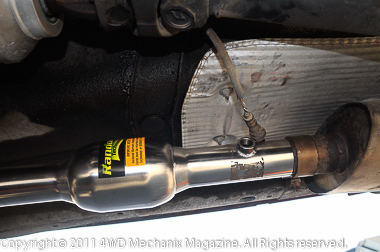
A topic of conversation in performance circles, the catalytic converter’s negative impact is exhaust back-pressure and some restriction. The cat, like a muffler, creates measurable resistance in the exhaust stream.
Emission controls are mandatory, and carbon monoxide, oxides of nitrogen and hydrocarbons are a detriment to air quality and the environment. The catalytic converter has become a requirement for U.S. vehicles operated on public roads—including the latest light truck diesel models. Even some racing classes require a catalytic converter, as clean air is an overall concern.
Fortunately, there is a way to get higher performance while still meeting emission control standards—at least in 49-State applications.* Random Technology offers highly efficient, SuperStainless™ aftermarket catalytic converters.
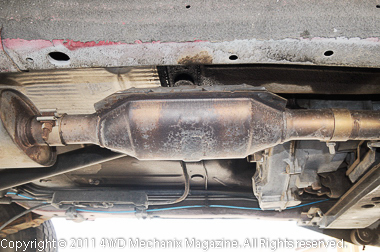
We installed the Random Technology ceramic-type cat six years ago, and it worked well for 40K miles. Discussion with Random Technology revealed possible performance and off-road reliability gains from an all metal cat design. We elected to test the low-restriction metallic cat.

In this how-to installation, a custom metallic cat is the exact replacement for the ceramic unit. Follow-up testing revealed a substantial gain in performance, even over Random Technology’s SuperStainless™ ceramic catalytic converter. Either of these designs would be our primary choices for improved cat performance and efficiency.
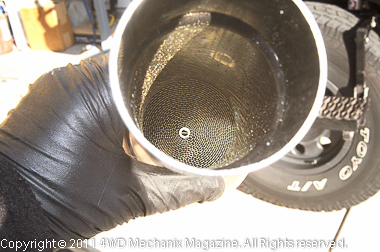
Noticeable immediately, the metallic cat has virtually no restrictive matrix. You can see through the unit! Its honeycombed, wafer element is visible at the center.
Clearly, the metallic cat unit is less restrictive. This translates to better exhaust system scavenging, which complements the Borla header and Borla turbo muffler.
The performance outcome is a readily sensed power and torque gain. Apparently, the Borla system was waiting to show what it could do—the 4″ shell, metallic cat sparked the system to new levels of performance! Tip the throttle, from idle or at speed, and the engine responds better!
The Random Technology metallic cat delivered as promised. In the process, we discovered the real gains available from the header and turbo muffler. Fuel efficiency will improve, too—once we get our foot out of the new-found throttle response…Contact Random Technology for more details.
Follow these how-to steps, as we replace the catalytic converter on the ’99 Jeep XJ Cherokee 4WD. If you want improved performance and fuel efficiency, this works!
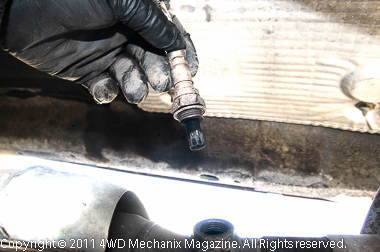
1. The catalytic converter serves the exhaust emission system. Cat function is monitored by the downstream oxygen sensor (shown). If the cat does not clean up the exhaust sufficiently on an OBDII system, the “Engine Check Light” will signal a DTC message. A ‘0420’ code will occur on this 1999 Jeep XJ Cherokee 4WD 4.0L six-cylinder model.
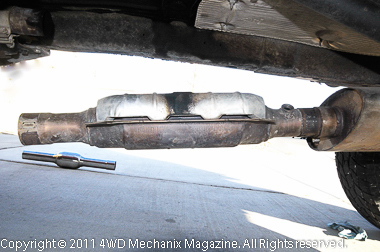
2. This Random Technology cat has served well for 40K miles. Fitted to the Cherokee with a Borla header and turbo muffler, the system delivered quality performance for years. A Random Technology metallic core cat will replace this unit.
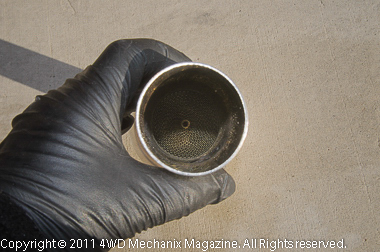
3. Heart of the metallic core cat is a wafered, honeycomb element. Restriction has been dramatically reduced. You can hold this 4″ SuperStainless™ cat to light and see through the center of the assembly!
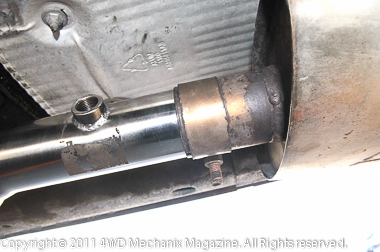
4. The new metallic cat fits in place of the ceramic core unit. Once the older unit is out, the new stainless inlet and outlet slide into position—an exact fit. Note the clamp type used here. These are phenomenal clamps for sealing. They also ease muffler or cat replacement after years in service!
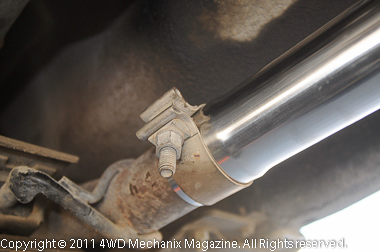
5. These clamps work really well with stainless steel components. The older cat came loose in minutes without a lot of fuss. New cat slides into place, clamped securely in just minutes! Torqued to 30-plus ft-lbs, re-torqued after a heat cycle, band clamps seal exceptionally well.
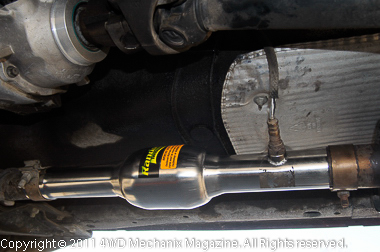
6. New cat in place with oxygen sensor installed properly, this unit is ready to go! Handle the oxygen-sensor wires carefully. Route wires away from the driveline, rough edes and out of the way for off-road use. Re-torque clamps after a full heat cycle.
Performance Comments Directly from Random Technology:
Catalytic converter flow has been at the root of discussions with Random Technology. Here are some comments from Random Technology regarding products:
“In fact, Random Technology high efficiency catalytic converters actually have a higher flow capacity than many mufflers. As an example, a 3″ diameter 7000 series SuperStainless catalytic converter flows 617 cfm. Most 3″ diameter high performance mufflers flow less than 475 cfm at the same test pressure…Random Technology direct fit SuperStainless catalytic converters are available for most domestic and imported vehicles. Custom catalytic converters with inlets and outlets up to 5” in diameter are available…Random Technology also offers metal matrix catalytic converters designed for maximum flow capacity. These high flow converters are designed specifically for use in sanctioned race classes that require the use of catalytic converters.”
For details on Random Technology products, visit the website—click here!
